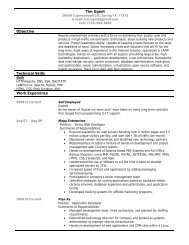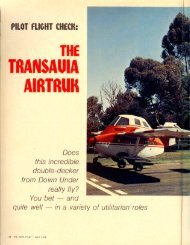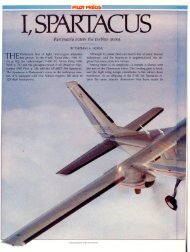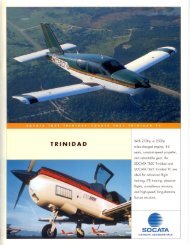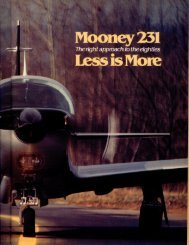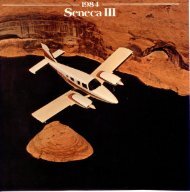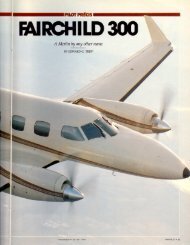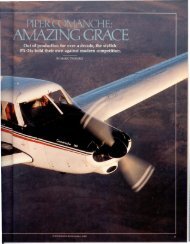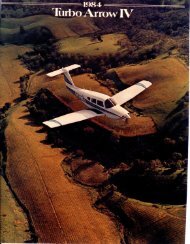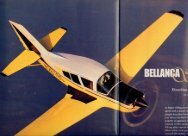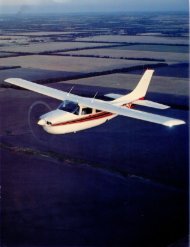marquise - Aero Resources Inc
marquise - Aero Resources Inc
marquise - Aero Resources Inc
- No tags were found...
Create successful ePaper yourself
Turn your PDF publications into a flip-book with our unique Google optimized e-Paper software.
Some people call the MU - 2 a rice rocket,others a job stealer. Beyond thepejoratives flies a superb turboprop.BY THOMASA. HORNE--,• ..apanese designers, who traditionallyare branded copiers of Westerninnovations, started with aclean slate when they beganwork on the Mitsubishi MU-2project. The goal, established inthe late 1950s, was to build ahigh-performance turboprop twin thatcould fly faster than the competition,land shorter and take on unimprovedfields-all while carting seven passengersaround in a modicum of luxury.Mitsubishi engineers had to use innovativeapproaches to meet thesechallengil)g goals, and the result is anairplane unique in the world's corporateturboprop fleet. For top-end performance,the MU-2 was given power---Ir.I.---.•PHOTOGRAPHY BY ART DAVIS72. APRIL1984
C01ttirrurdful Garrett AiResearch TPE331turboprop engines and relatively small,laminar-flow wings. Full-span, Fowlertypeflaps provide the extra lift andlower stall speed needed for slow flightand short-field takeoff and landingspeeds. To handle the shocks fromrough fields, fuselage-mounted landinggear based on that of the Lockheed F104 fighter (Mitsubishi at one timebuilt F-104s under license from Lockheedand the U.S. Government) waschosen. And the MU-2's high-wing designpermits two feet of propellerground clearance, protecting the propsfrom stone damage and ground strikes.The MU-2's Federal Aviation Administrationtype certificate was granted inNovember 1965. From the moment itwas introduced into the United States,the airplane created a sensation. Itssmooth lines, aggressive appearance,heavy-duty construction, spoilers andflaps injected some fresh air and advancedconcepts into the turbopropmarket. The lure of having a nearSTOL hot rod capable of blasting outof a 2,000-foot strip, then scorchingalong at a King Air-killing 300-plusKTAS also played a large part in earningthe MU-2 its place in the Americanmarket. It has a macho appeal as a pilot'sairplane-a reputation built onspeed and its unconventional controlfeel and the perception that it is difficultto land smoothly, irksome in acrosswind and difficult to control if anengine fails.There are spoilers for roll control inthe MU-2, and the idiosyncrasies ofthis control arrangement challengemany pilots on their first few outings.The good news about the spoilers isMARQUISEthat they bring crisp turns without theadverse yaw that ailerons produce.They also are more effective than aileronsat slow airspeeds. The bad newsis that they create large amounts ofdrag, and in an engine-out situationthis is the last thing you need whentrying to reconfigure the airplane for asingle-engine climb.First impression of the spoilers' controlfeel is that they have the artificialfeel of an arcade-game linkage. Thereis a flat spot in the control yoke's linkage,and when you release the controls,the yoke springs back to the horizontal,center position.Since the spoilers cannot be used totrim the MU-2 in the roll axis, Mitsubishigives the airplane electrically driventrim ailerons. These ailerons are at theflaps' trailing edges and can be positionedup to 14 degrees up or down tohelp trim the airplane wings-level. Thedrill for trimming is to leave the yokein the center and blip the trim switchuntil the wings level.During takeoff and landing, spoilerinputs should be kept to a minimum.The spoilers are so sensitive that thepilot could enter a pilot-induced-oscillationas he chases his roll inputs.For takeoff, using 20 degrees of flapsis standard procedure. This enlargesthe airplane's small wing area by 42square feet (it measures only 178square feet, just four square feet largerthan a Cessna 172's wings). This increaseslift and lowers the MU-2's stallspeed from 106 knots (clean configuration)to 85 knots.Even with the help of the flaps,there is exposure to a period of marginalcontrollability should an enginefail on climb-out. With a rotation speedof 90 knots, a gear retraction time of 13seconds and a Vyse (single-enginebest-rate-of-climb speed) of between140 and 152 knots, an MU-2 can takeseveral tense seconds to accelerate to asafe climb speed, if an engine fails inthe initial stages of the climb-out.Compounding the mystery of howlong this can take is the absence of anyaccelerate/go charts in the performancesection of the MU-2 manual. Anaccelerate/go chart indicates the distancean airplane will need to clear a 50foot obstacle, assuming an engine failureat lift-off and immediate feathering ofthe inoperative engine. Configurationchanges bring with them the need toretrim the MU-2 about all three axes. Ittakes a while to acquire the deft touchthat an MU-2 pilot needs to make efficientroll and yaw trim inputs. This workload is an unwelcome chore during instrumentapproaches and can be a dangerousdistraction for untrained pilotscoping with an emergency.Landings provide the most challengefor MU-2 pilots. Experienced instructorsclaim that a minimum of 30 landingsis required for an initiate to get thehang of it, true of any airplane in thiscategory. The usual procedure is tocome down final at 120 knots with 20degrees of flaps, then cross the thresholdat 90 to 100 knots (depending onthe airplane's gross weight) and touchdown at 80, carrying a small amount ofpower. The thrust levers-the turbopropequivalent of a reciprocating engine'sthrottles-should be positionedjust ahead of Flight Idle.Full flaps (40 degrees) can be selectedon final approach when committedto land, but their use is discouragedin single-engine landings and in IFRconditions when ceilings are near minimums.If a single-engine go-around becomesnecessary, a full flap MU-2, aswill any twin, will take too long toreconfigure for a climb, and the pilotmay have to nose the airplane over inorder to pick up the necessary climbairspeed. The low-ceiling caveat has todo with the airplane's tendency to balloonwhile lowering the last incrementof flaps. The problem is that it mayballoon back into the overcast, necessitatinga missed approach.The MU-2's high wing loading (65pounds per square foot in the newerMarquise models) and propeller dragoften means a high sink rate if poweris removed as the airplane nears touch-74 • APRIL 1984
•••Much of the equipmellt ill the MU-2's well-equippedcockpit is stalldard, illcludillg a Sperry autopilot/[light-director system. A kllowll-icillg package isalso stalldard. Passellgers are well accommodated, too.AOPA PILOT • 75
Ctmti"ueddown. This is usually followed by afirm arrival on the main gear. Thenosewheel is soon to follow (unless thepilot hauls back on the stick), and theimpression of a hard landing is reinforcedby the noise transmittedthrough the airframe by the fuselagemountedlanding gear. Though the airplanecan be made to land smoothly,greasers are infrequent and experiencedonly by those who diligentlykeep the power in until the mainwheels touch. You must fly the airplaneright onto the runway.Once the airplane- has toucheddown, reverse thrust can shorten theground roll dramatically. This is perhapsthe most satisfying element of anMU-2 landing. Landing distances of1,800 feet are common, and precise pilotsrarely miss the first turnoff.To keep the landing from becomingany more exciting, pilots must be preparedfor the yawing that frequentlyaccompanies an MU-2 arrival. With somuch weight on the nosewheel (approximately1,700 pounds on thenewer models), the weight of the fuelin the tip tanks and the rarity of pullingequal amounts of reverse thrust oneach engine, the airplane can beginyawing during the rollout. Crosswindsaggravate this situation.The operation of the GarrettAiResearch TPE331 engines is a snap,especially in the more recent Solitaireand Marquise. These engines comewith a single redline (SRL) computer,the brain behind the newer Garretts'MARQUISEThe distinctive shape of the MU-2 is apparentfrom any angle. The main gear doors are huge.The large slotted, Fowler-type flaps increase wing area from J 78 square feet to220 square feet when extended to the 20-degree (takeoff and approach position.The above picture shows the flaps fully extended. The horizontal stabilizer hasa pronounced inverted airfoil shape (below). The strake has a sharp leading edge.76. APRIL1984
starting sequence. Other modem turboproptwins (such as the GulfstreamCommander 1000 and Fairchild) alsouse the SRL-equipped TPE331.Push the Start button on the powerquadrant, and the computer starts theengine for you. The engine rotates, fuelis admitted to the combustion chamber,and ignition occurs at 10-percent rpm.The computer also "calculates" ambienttemperature and pressure conditionsto allow a constant exhaust gastemperature redline limit of 650°C.This relieves the pilot from figuring adifferent redline before each enginestart. The pilot still must monitor theengines' temperatures, though, so thatlimitations are not exceeded. Earliermodels (from the MU-2B through theMU-2P) do not have engines with SRLcomputers, and pilots must calculateredlines using a chart. The SRLs' maindrawback is that the engines will notstart if they malfunction.Because the TPE331s have a singleshaftdesign, and are mated with widechordpropellers, Garrett engineers hadto come up with a means of reducingthe huge amounts of drag that a failedengine's windmilling propeller couldgenerate. The TPE331 's propeller isconnected to the same shaft that holdsthe engine's compressor and turbinewheels. When a propeller windmills, itdrives the entire engine. A negativetorque sensing (NTS) system is used onTPE331s to sense when the propeller isturning the engine. If the propeller beginsto windmill, the NTS signals thepropeller to move toward the Featherposition, reducing drag. This is sometimesreferred to as an auto-featheringdevice. That is incorrect. The NTSmerely allows the windmilling propeller'sspeed to match the dying engine'srotational speed; the pilot still has tomove the condition levers to EmergencyStop to feather the propellercompletely. Taking off with an inoperativeNTS system is prohibited.Garrett powers all MU-2s to someimpressive true airspeeds. Even thefirst MU-2Bs, with the 605 eshp(equivalent shaft horsepower: the additionof the exhaust thrust to the engine'srated horsepower) engines,could turn in a 269-knot cruise speed.A new Marquise's engines put out 778eshp and 307 KTAS. The Solitaire, theshort-body hot rod of the series, does320 KTAS at its maximum cruisepower of 98-percent rpm.Over the years, Mitsubishi has beenable to say that the MU-2 is the fastestcorporate turboprop in the world. Thistitle recently has been challenged bythe 293-knot Cessna Conquest II andthe new, 321-knot Beech Super KingAir 300. Still, at their lightest weights,highest power settings and most favorableoperating conditions and altitudes,the new Piper Cheyenne III will do296 KTAS, the Beech Super King AirF90, 269 and the Gulfstream Commander1000, 303. The MU-2, knowninformally as the "rice rocket," bests allthese speeds, but only when operatingbetween 18,000 and 21,000 feet.That is what the performance chartssay, but some operators say that MU-2swith the "pre-Century" (TPE331-1O)engines (the TPE331-2SAA, -1, -5, and-6) lose power above 10,000 feet or so.Most of these gripes center around theolder Garretts' inclination to lose availablepower after about 1,000 hours ofoperation. Some have found that prematurecompressorwear are to blame.and turbine bladeThe Solitaire's and Marquise's -10engines have had problems, too.Premature carbon build-ups haveprompted Garrett to design what itcalls a carbon-free combustion chamberfor -10 engines built after mid-1983.But these problems pale in significancewhen you consider the costly airworthinessdirectives (ADs) leviedagainst several hundred engines in theMU-2 fleet. A series of expensive ADs,beginning with AD 78-4-5 and culminatingwith AD 84-1-4, require thatmany pre-Century engines have theirthird-stage turbine wheels replaced.This AD resulted from several incidentsand accidents in which defectiveturbine wheels failed catastrophically.Garrett prefers to keep all of its engines'maintenance work in its 21 servicecenters and seven overhaul shops.Garrett shops will take care of the ADcompliance for a flat rate of $5,900 perengine. Overhauls run an average of$63,800 per engine. Hot-section maintenanceis billed at a fIat rate of$20,000 per engine. Hot-section workmust be performed at 1,800-hour intervalsand involve cleaning, inspectionand repair of the combustion chamber,compressor and turbine wheels.Non-Garrett-approved service facilitiesmay be able to beat Garrett's pricesin certain cases. For example, MontanaJet Star, of Billings, Montana, says itwill do Garrett overhauls for $50,000per engine and a hot-section for anywherefrom $3,500 to $lS,OOO-dependingon maintenance needs.If the MU-2's engines have beentroublesome, its airframe has provenunusually reliable. There have been 13airframe ADs, most of them minor.Mitsubishi reports a dispatch reliabilityof 98 percent and at one time offered a2S,000-hour warranty on the airframe.Today, a Mitsubishi spokesman says,the warranty extends "several years."When the MU-2 was introduced inthe United States in 1967, MitsubishiHeavy Industries contracted with theMooney Aircraft Company to handlethe MU-2's American assembly, salesand maintenance operations. Mooneybuilt an assembly facility in San Angelo,Texas, where MU-2 partsshippedin three crates from the primaryfactory in Nagoya, Japan-weremade into the finished product.Mooney ran the Mitsubishi programuntil 1970, when Mooney's bankruptcyand charges against Mooney corporatechiefs convinced the home office to assumedirect control. Mitsubishi establisheda wholly owned subsidiary,Mitsub~shi Aircraft International, totake care of its aviation business. Since1970, MAl has expanded the San Angeloplant and established a worldwidecorporate headquarters in Dallas.From the early days of the "MooneyMU-2" through the current Solitaireand Marquise models, the airplane hasundergone a series of hefty jumps inpower, gross weight and useful load.The airplane's electrical, environmentalAOPA PilOT • 77
COlltilluedand pressurization systems also havebeen refined over the years. This, andcompetitive pricing (an averageequipped1967 MU-2B sold for approximately$390,000; a 1967 BeechKing Air A90 went for about $420,000)started sales off on a strong note.But by 1981, MU-2s had been involvedin several attention-getting accidents.NTSB began to question theMU-2's design. One investigation centeredon the Garrett engines. Investigatorswondered if toxic fumes leakingpast an engine seal, through the pressurizationsystem and into the cabincaused a number of unexplained accidents.Investigations, however, exoneratedthe MU-2's engines and pressurizationsystem. Though stillpuzzled, NTSB gave the MU-2 a cleanbill of health.A series of 31 fatal accidents thattook place between 1975 and 1983prompted NTSB to issue safety recommendationA-83-56, in which it recommendedthat the FAA conduct a specialcertification review of the MU-2. TheFAA agreed, and ordered a certificationreview. All the subjects mentioned inthe recommendation have been includedin the review.NTSB wanted a study of the airplane'sengines, fuel, autopilot andflight control systems; flight in knownicing-conditionscharacteristics; inoperativeengine characteristics; and handlingcharacteristics during IFR landingapproaches. Critics of the MU-2latched onto the sensationalism, and itsMARQUISESome pilots call thelarge main gear enclosuresdolly partons.reputation as a "pilot-killer" was born.Now the MU-2's strengths havebeen cast in a new light. The wingsand powerplants that drive the airplaneto such high speeds now are beingscrutinized. Is the yaw and rollproduced by asymmetric thrust inordinatefor this category of airplane? Arespecial operational procedures necessary?Does the potential exist to improvethe Garrett engine's design andmaintenance procedures? Most of theengine-failure accidents involved hightimeMU-2 pilots. Why, NTSB wondered,were they not able to handle anemergency procedure with which theyshould have been prepared to deal?The fuel system is being questionedbecause of double-engine flameout accidents.The fuel system was designedwith simplicity and low pilot work loadin mind. Bleed air from the engines'compressors pumps fuel from the tiptanks to two outer wing tanks. Fromthere, electric transfer pumps movefuel to a center tank. The engines drawfrom the center tank only. The tanksdeplete from the tips inward, and thereis a manual override to help balancefuel loads in the outer wing tanks.There are no crossfeed controls.The fuel systems' biggest drawbackis that contaminants in anyone tankeventually will find their way to bothengines. The 1967 MU-2B had an additionalproblem: A lack of discrete systemsfor pressurized air to the deicerboots and tip tanks meant that, if theseairplanes lost pressurization, they lostthe use of their tip fuel and boots, too.This problem was corrected beginningwith the MU-2D models.The MU-2's behavior in icing conditionswas included in the NTSB recommendationout of a suspicion that theMU-2's high wing loading and spoilersmay compromise the airplane's performancein icing conditions, though thewording of the recommendation wasnot specific on this point. The implicationwas that the airplane's inability tohandle icing may have caused severalotherwise unexplainable accidents.Still other accidents caused by whatNTSB calls a "sudden, unexplainedloss of control" brought up the questionof the MU-2's stability in instrumentmeteorological conditions. TheNTSB recommendation suggests thatthe MU-2 is too short-coupled, trimhungryand squirrely to be anythingbut a Pandora's box in IFR flight.As we go to press, the certificationreview had not been completed. But aMitsubishi spokesman stated that sofar tests had proven that the MU-2 is"in compliance with all the certificationrequirements that were in effect at thetime the MU-2 received its typecertificate."78. APRIL1984
Some safety experts believe that thepattern of MU-2 accidents suggestseconomic roots. According to this theory,when the MU-2 was young, it attractedclientele from well-heeled corporationsand from the ranks of thoseseeking high-performance twin-engineturboprop airplanes-those who had aprofessional attitude toward flying andwho maintained their proficiency.As MU-2s entered the used market,they represented a relatively inexpensiveway for less affluent owner/pilotsto move up from piston twins to amuch faster turboprop. The GarrettAD, the accidents and the certificationreview have all driven the selling priceof used MU-2s to ever-lower levels.The Aircraft Bluebook prices of the earlier,less powerful, low- TBO and lessrefined models are especially tempting.A 1967 MU-2B is listed at $125,000;the 1968 MU-2D can go for as low as$130,000, according to book prices.Even later models-such as the 1972to 1974 MU-2K, with its 724-eshp engines,higher service ceiling, 3,600hour TBO, dual electrical bus and batterysystem and higher useful loadreportedlywill go for some $320,000.Tempting, for those looking at theprices of new turboprops that cannotgo as fast. The danger is that operatorswith an unprofessional attitude maytry to bargain with safety and opt for acursory, cut-rate check-out.Mitsubishi and FlightSaftey International(FSI) realize that the MU-2 is ademanding airplane and that pilotknowledge, competence and proficiencyare the keys to preventing accidents(see "Turbine Time in the Box,"this page). Since 1975, FSI has beenconducting pilot training for the MU-2at its training center in Houston. In1982 and 1983, Mitsubishi paid substantialportions of more than 150 pilots'tuition for the course. The cost ofthe FSI pilot initial course is includedin the price of all new MU-2s. UsedMU-2s sold through the Mitsubishiused aircraft department also have theFSI course included in their price. FSI'sMU-2 pilot initial course costs $6,750;recurrent training costs $3,275 for asingle, one-week session or $4,725 fora package of two annual one-week sessions.Mitsubishi offers its own scaleddownversion of a proficiency programin its P.R.O.P. (Pilot's Review of Proficiency)seminars and videotapes.Compounding the MU-2's troubledTURBINE TIME IN THE BOXin the MU-2's tailcone, behind the mirror atthe aft cabin, is a large, 200-amp circuitbreaker. If it pops (as it is wont to do duringengine starts), if the pilot flies with the electricalsystem in this state and if the airplaneloses an engine-driven generator and a battery,the remaining generator and batterywill not be able to power the airplane's fullelectrical system. The MU-2 uses a dual-buselectrical system, but if the big circuitbreaker behind the mirror has popped, theadvantages of this system are cut in half. Ifthe 200-amp circuit breaker does not checkout during the preflight bus tie check, thepilot has to perform some extra preflightduties. He has to remove the mirror, thenreset the circuit breaker (a broom handleworks well) before taking off.This little procedure, while not as criticalto the safety of flight as the handling of anengine failure, is indicative of the detail impartedto pilots who attend FlightSafety International'spilot training courses. It is aprocedure that you will not find in the Mitsubishipilot's operating handbook, but onethat the well-trained MU-2 pilot shouldknow. The absence of this and other importantdetails in the MU-2's operating handbookmakes the FSI course a valuable additionto a pilot's competence. Amplifiedexplanations of both normal and emergencyprocedures are missing in the MU-2's manualas well as accelerate/go performance charts.FlightSafety International is an impartialbroker of safety. It has no airplanes to sellonlyfive days, 20 hours of ground schooland 10 hours of simulator flight in its pilotinitial curricula. FSI represents the bigleague in the world of pilot training andproficiency. With a client list that includesthe flight departments of virtually everymajor American corporation and courses fornearly every heavy piston twin, turbopropand business jet on the market, FSI's trainingcenters enjoy a booming business.At the heart of the FSI training program isa fleet of very sophisticated simulators.Manufactured by a subsidiary of FlightSafety, these simulators create a very realisticenvironment in which to practice emergencyprocedures and gain familiarity withan airplane's performance limitations.In the simulator's cockpit, you will findeverything that appears in the real airplane,right down to the ashtrays. A computer ensuresthat the simulator will react to pilotinputs in an authentic manner. Surroundingthe windshield are projectors that give thepilot realistic nighttime scenes that includenot only runways and airports, but othergeographic features-bridges, obstructions,causeways, monuments, whatever a particularairport environment calls for.The beauty of the simulator is that it allowsyou to experience dire emergencieswithout the worry of crashing-and allowsyou to repeat emergency procedures untilyou are proficient.In the MU-2 simulator a pilot can experienceengine failures on takeoff-this cannotbe simulated safely using the airplane. Untilthe pilot has his procedures nailed down, heprobably will "crash." It is an effective wayof showing the right and wrong ways tohandle an emergency.But engine failures are just one of a myriadof emergencies in store for the MU-2trainee. Here are some of the emergenciesyou can look forward to in training:Hot start; hung start; failed overspeedgovernor during runup; engine fire on thetakeoff roll; split flap after takeoff; enginefailure immediately after takeoff; generatorfailure; inverter failure; boost pump failure;single-engine ILS, VOR and NDB approaches;electrical fire; trim aileron failure;landing-gear malfunctions; pitch trim runaway;engine failure during VFR approach;engine failure at MDA and DH during instrumentapproaches; single-engine goaround.An instructor can dial in any number ofmalfunctions or meteorological hazards. Hepushes one button, and you lose the fuelcap on the tip tank and begin venting fueloverboard. He pushes another, and the NTSfails. He dials in an overgross condition,moves the center of gravity too far aft, setsan engine on fire, punches up severe turbulenceand icing, then makes you shoot anapproach with a fuel imbalance in zero-zeroweather conditions. All of this is possible,and very convincing.If simulator time is the glamorous portionof an FSI course, the ground school is themeat and potatoes. The curriculum is designedso that you learn about a system in amorning session, then ride the simulator inthe afternoon for hands-on experience.FSI claims that it has achieved a 20-percentpenetration of the MU-2 pilot population.The percentage should be higher; theMU-2 is kind only to the proficient.Perhaps the cost of the course ($6,750 forthe pilot initial) drives some operators away,even though reduced insurance rates areavailable to FSI graduates.But fast-and-dirty check-outs are a falseeconomy in the MU-2. It may be perfectlylegal for a pilot to earn his multi-enginerating in a Piper Seminole, then plunkdown his cash and hop in an MU-2 as pilotin command. Some salesmen use this as apitch to a prospective purchaser's ego.But there is a right way and a wrong wayto transition to one of the hottest turbopropsin the world. And a few touch and goes inthe pattern is just not enough.The MU-2 training courses are held atFSI's Houston Learning Center, 7525 Faunaat Airport Boulevard, Houston, Texas77061; 713/644-1521. -TAHAOPA PilOT • 79
image is the recent protectionist sentimentagainst products of Japanese origin.Ever since the early 1960s, Japanesegoods have claimed an ever largershare of the American market. Andwhat began with television sets, computers,automobiles and steel, conservativesfear, may yet extend to the aviationindustry. Concerned executivesrepresenting Piper, Beech, Cessna,Mooney, Gulfstream <strong>Aero</strong>space andFairchild Aircraft have formed theAmerican Business Aircraft Committee(ABAC). This organization has sent let-MARQUISEters to many major corporations urgingthat they buy American-made airplanes.The committee echoes thegeneral feeling pervading Americanbusiness today: that foreign, govern-MU-2ADesign work on the MU-2 in 1959. The first prototype of an MU-2had its maidCll flight in September 1963. This model, designatedthe MU-2A, was powered by two 562-eshp Turbomeca Astazou IlKe/lgines. Plans to market the MU-2A were canceled in 1965 afterthree aircraft were built.SPOITERS GUIDEMU-2BFirst flew March 11, 1965. Marketed 1965 to 1967; 28 sold. Poweredby 605-eshp Garrett TPE331-25AA or AB engirles; 2,000-hour TBO.Seats seven to Iline. Certified ceiling, 25,000 feet; 4.16-psi pressurizationsystem. Max cruise, 315 KTAS. Empty weight, 5,615pounds; max takeoff weight, 8,930 pounds. Fuel capacity, 295 gallons.Price Ilew, $390,000; current blue book price, $125,000.MU-2CAn unpressurized version sold to the Japanese Ground Self-DefenseForce for liaison and reconnaissance.MU-2G(MU-2B-30)First of the long-body MU-2s. Relocation of main gear in fuselagepods gives wider cabin dimensions. Marketed 1970 to 1971; 45 sold.Same engirles as F model. Seats seven to 10. Certified ceiling, 25,000feet, five-psi pressurization system. Max cruise, 283 KTAS. Emptyweight, 6,700 pounds; max takeoff weight, 10,800 pounds. Fuel capacity,375 gal/ons. Price new, $528,000 to $570,000; curmlt blue/book price, $265,000 to $270,000.MU-2JMU-2D(MU-2B-1O)Marketed in 1968; 16 sold. Powered by 605-eshp TPE331-25AA ellgirles;2,000-hour TBO. Seats seven to nine. Speed, ceiling and pressurizationspecifications same as MU-2B. Empty weight, 5,700pounds; max takeoff weiglJt, 9,350 pounds. Fuel capacity, 289gal/ons. The D was the first of the series to use wet wings. Precedingmodels have bladder tanks. Price new, $403,000; current bluebook price, $130,000.MU-2EAn unpressurized search and rescue version built for theJapanese Air Self-DefCllse Force.MU-2F (MU-2B-20)Marketed 1968 to 1972; 112 sold. Uprated, 705-eshp GarrettTPE331-1-151A CCIltury engines; 3,600-hour TBO. Seats seven tonine. Five-psi pressurization system. Max cruise, 296 KTAS. Emptyweight, 6,300 pounds; max takeoff weight, 9,920 pounds. Fuel capacity,375 gal/ons. Price new, $437,000 to $482,000; current blue bookprice, $260,000 to $287,000.MU-2/(MU-2B-35)Long-body. Marketed 1972 to 1974; six sold. Powered by 724-eshpTPE331-6-251M engines; 3,600-hour TBO. Seats seven to 11. Certifiedceiling 25,000 feet. Max cruise, 300 KTAS. Empty weight, 6,800pounds; max takeoff weight, 10,800 pounds. Price new, $622,000 to$745,000; current blue book price, $360,000 to $375,000.MU-2K(MU-2B-25)Marketed 1972 to 1974; 77 sold. Same CIlgines as J model. Seatsseven to nine. Max cruise, 317 KTAS. Empty weight, 6,350 pounds;max takeoff weight, 9,920 pounds. Price new, $568,000 to $632,000;current blue book price, $320,000 to $335,000.
ment-subsidized manufacturers areflooding the U.s. market with goodsartificially priced at very low levels.ABACclaims that foreign aircraft manufacturerssuch as Embraer, Canadair,de Havilland, Avions Marcel Dassault,Israeli Aircraft, British <strong>Aero</strong>space andMitsubishi have an unfair advantageover U.s. manufacturers. "The buyer ofa foreign airplane (or almost any otherproduct) may be saving a few dollarswhile overlooking the cost to the U.s.economy in lost taxes, lost jobs, higherunemployment benefits and a slowerrecovery from recession," ABAC asserted.To point out what it considersthe magnitude of the problem, ABACclaims 43 percent of all business jetsdelivered in the United States in 1983were foreign products.That Mitsubishi is a Japanese firm,MU-2L(MU-2B-36)Long-body. Marketed 1975 to 1976; 33 sold. Powered by 776-eshpTPE331-6-251M engines. Seats nine to 11. Six-psi pressurizationsystem. Max cruise, 296 KTAS. Empty weight, 7,570 pounds; maxtakeoff weight, 11,575 pounds. Price new, $794,000 to $790,000;current blue book price, $450,000 to $465,000.MU-2P(MU-2B-26A)Marketed 1977 to 1978; 46 sold. Powered by 724-eshp TPE331-5252M engines; 3,600-hour TBD. Certified ceiling, 28,000 feet. Maxcruise, 316 KTAS. Empty weight, 6,898 pounds; max takeoff weight,10,470 pounds. King Gold Crown radios, radar and flight directorstandard. Price new, $785,000 to $850,000; currellt blue book price,$425,000 to $450,000.MU-2M(MU-2B-26)Marketed 1975 to 1976; 28 sold. Powered by 724-eshp TPE331-6251M eIlgines; 3,600-hour TBD. Seats seven to nine. Certified ceiling,28,000 feet; six-psi pressurization system. Max cruise, 317KTAS. Empty weight, 6,892 pounds; max takeoff weight, 10,470pounds. Price new, $687,000 to $708,000; current blue book price,$360,000 to $375,000.MU-2N (MU-2B-36, -36A)LO/lg-body. Marketed 1977 to 1978; 42 sold. Powered by 776-eshpTPE331-5-252M engines. Certified ceiling, 25,000 feet. Max cruise,296 KTAS. Empty weight, 7,696 pounds; max takeoff weight, 11,575pounds. Slower-turning engines at takeoff power (1,591 rpm; earlierMU-2s developed 2,000 rpm), new four-blade propellers and bettersOUlldproofing mark this and all succeeding models. King GoldCrown radios, radar and flight director standard. Price new,$915,000 to $995,000; current blue book price, $550,000 to $575,000.Solitaire(MU-2B-40)Marketed 1979 to 1984; 55-plus sold. Powered by 727-eshpTPE331-1O-501M engines; 3,000-hour TBD. Seats seven to nine. Certifiedceilillg, 31,000 feet. Max cruise, 321 KTAS. Empty weight, 7,101pounds; max takeoff weight, 10,470 pounds. Fuel capacity, 415 gallons.Full IFR equipment standard. Price new, $980,000 to $1,852,000(1983). Current blue book price, $520,000 to $1,000,000 (1982).MarquiseMarquise (MU-2B-60)Long-body. Marketed 1979 to 1984; 128-plus sold. Powered by 778eshp TPE331-1O-501M engines; 3,000-hour TBD. Seats nine to 11.Certified ceiling 31,000 feet. Max cruise, 307 KTAS. Empty weight,7,650 pounds; max takeoff weight, 11,575 pounds. Fuel capacity, 415gallons. Full IFR equipment standard from 1980 on. Price new,$1,235,000 (1979) to $1,852,000 (1983); current blue book price,$690,000 to $1,852,000 (1983).TAHAOPA PilOT. 81
COlftillUt'dthat Japan has been so successful incornering large markets in the UnitedStates and that Japan discouragesmany U.s. imports through protectivetariffs and complicated quota schemes,does not help Mitsubishi's case againstAmerica's protectionists. Though theJapanese government's powerful Ministryof International Trade and Industrypromotes Japanese business abroad,Mitsubishi is not government-ownedor -operated. Still, the company islinked with the dumping practices ofother Japanese products. The fact is,with 735 total sales, the MU-2 representsa minor threat to domestic turbopropmanufacturers. Beech's King Airsales total 3,662, and Piper has sold aMitsubishi MU-2B-60 MarquiseBase price $1,675,000Price as tested $1,735,210AOPA Pilot Operation/Equipment Category·:All-weatherBase price includes full complement of IFRequipment, Sperry SPI-40Ic/RD-44 flightdirector and altitude-heading system andknown-icing certification.SpecificationsPowerplants Two Garrett AiResearchTPE331-IO-s0IM715 shp, 778 eshpRecommended TBO3,000 hrPropellersTwo Hartzell, four-blade,constant speed, full-feathering,reversible-pitch, 98-in dia;blade model LT 10282B-s.3RLengthHeightWingspanWing areaWing loadingPower loadingSeatsCabin lengthCabin width39 ft 5.4 in13 ft 8 in39 ft 2 in178 sq ft65 Ib/sq ft8 Ib/hpII19 ft 8 in4 ft II inCabin height4 ft 3 inEmpty weight, std7,650 IbEmpty weight, as tested7,854 IbMax ramp weight11,625 IbUseful load3,925 IbUseful load, as tested3,721 IbPayload w/full fuel1,225 IbPayload w/full fuel, as tested 1,0211bMax takeoff weight 11,5751bMax landing weight 11,0251bZero fuel weight 9,9501bFuel capacity, std 2,780 Ib (2,700 Ib usable)415 gal (403 gal usable)Oil capacity, ea engine6 qtBaggage capacity600 Ib, 44 cu ftPerformanceTakeoff distance, ground rollTakeoff distance over 50 ft obstAccelerate/stop distanceMax demonstrated crosswindcomponentI I Rate of climb, sea levelSingle-engine ROC. sea levelMax level speed, 20,000 ft1,825 ft2,170 ft3,300 ft22 kt takeoff18 kt landing2,250 fpm425 fpm307 ktMARQUISEtotal of 897 turboprop twins since1974. Cessna's total twin turbopropsales are 502-in only four years.Mitsubishi points out that all of itsMU-2 turboprops and Diamond-seriesturbojets are assembled in Texas andthat the company thus benefits theAmerican economy. Mitsubishi paysAmerican taxes, employs American laborand uses American materials in theconstruction of its airplanes. The companyclaims that 70 percent of an MU2's parts and labor are American.For all the clamor, MU-2 owners andCruise speed/Range w/45-min rsv, std fuel.ISA (fuel consumption, ea engine)Recommended cruise power, 96% rpm,100% torque or 650°C EGT14,000 ft296 kt/950 nm(698 pph/104.1 gph)28,000 ft280 kt/I,350 nm(464 pph/69.2 gph)Maximum range power14,000 ft, 67% torque28,000 ft, 61% torque255 kt/I,OOO nm(558 pph/83.2 gph)273 kt/I,375 nm(450 pph/67.1 gph)31,000 ft29,750 ft18,200 ft1,880 ft1,128 ftMax operating altitudeService ceilingSingle-engine service ceilingLanding distance over sO-ft obstLanding distance, ground rollLimiting and Recommended AirspeedsVmc (Min contdrol w/critical engineinoperative) flaps 20 degreesVx (Best angle of climb)Vy (Best rate of climb)Vxse (Best single-engine angle ofclimb)Vyse (Best single-engine rate ofclimb)Va (Design maneuvering)Vfo (Flaps operating)o to 5 degrees5 to 20 degrees20 to 40 degreesVfe (Max flap extended)5 degrees20 or 40 degreesVie (Max gear extended)Vlo (Max gear operating)ExtendRetractVno (Max structural cruising)Vne (Never exceed)Vr (Rotation)VSI (Stall clean)Vso (Stall in landing configuration)All specificationsare based on manufacturers99 KIAS128 KIAS134 KIAS140 KIAS152 KIAS191 KIAS175 KIAS155 KIAS120 KIAS175 KIAS155 KIAS175 KIAS175 KIAS175 KIAS250 KIAS250 KIAS90 KIAS106 KIAS81 KIAScalculations. All performance figures are basedon standard day, standard atmosphere, at sealevel and gross weight, unless otherwise noted.·Operations/Equipment Categories are definedin June 1983 Pilot. p. 96. The prices reflectthe costs for equipment recommended to operateii, the listed categories.ing of the MU-2. There is talk of anew-generation Mitsubishi turboprop'sappearance in four years and the suspensionpf MU-2 production. There isevidence that Mitsubishi is devotingmost of its energy to its new entrantsin the business jet market, the DiamondIA and upcoming Diamond II.Regardless of Mitsubishi's future dispositionof the MU-2, it is a safe betthat this controversial airplane will endureas a general aviation classic andwill continue to live out its image asone of the most potent, most challengingand most misunderstood of all corporatetwins. 0FROM SAMUAAI10 SAN ANGELOMitsubishi Heavy Industries is ahuge, diversified conglomerate thatmanufactures everything from shipsto soft-ice-cream machines, steeloperators still have a fierce loyalty tothe airplane. But Mitsubishi may be tir-mills to dry-cleaning equipment, locomotivesto automobiles and oil rigsto airport mobile lounges. Aircraftmanufacturing is only one part ofMHI's business interests.Mitsubishi, which means three diamondsin Japanese, was founded in1857 by a samurai, Iwasaki Yataro.He managed to take over all thecommercial and shipping business inhis native district. The Japanese government,which saw in Iwasaki away to free Japan of dependence onforeign shipping, bought him 13ships to help him fulfill his contracts.By 1879, Mitsubishi's fleet was a majoreconomic force in East Asia.Mitsubishi entered aviation in1920, when it designed a carrierbasedtorpedo bomber for the JapaneseImperial Navy. By the end ofWorld War II, Mitsubishi had built 57types of warplanes (including the notoriousZero-sen fighter and Ki-67 seriesof bombers) totaling more than18,000 aircraft and 52,000 engines.Mitsubishi's interest in aircraft continuedin the postwar years. Underterms of licensing agreements, Mitsubishibuilt North American F-86fighters, Lockheed F-104s, McDonnellDouglas F-4Js and F-15s and Sikorskyhelicopters. Mitsubishi alsobuilds a supersonic fighter of its owndesign, the F-1, and a supersonictrainer, the T-2. There is also theDiamond series of business turbojetsand, of course, the MU-2 series ofbusiness turboprops. Total Mitsubishiaircraft delivered number approximately20,100.-TAH]sIp f1J



